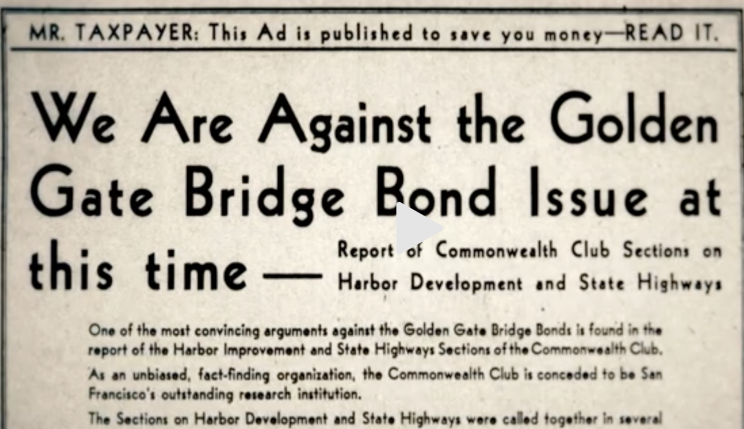Happening Now
From The Golden Gate to High-Speed Rail
August 4, 2023
by Jim Mathews / President & CEO
Whether your own must-see-TV is The Bear, Jack Ryan, Succession, or Black Mirror, I’d love to get all of you to set aside a little less than an hour of your TV viewing routine this weekend to watch a new PBS documentary that hits close to home for all of us – transportation, infrastructure, and the challenge of why we find it so hard in the modern era to imagine and build great things.
The program is “Iconic America: The Golden Gate Bridge.” Nominally it’s about the Golden Gate Bridge, how it came to be, the opposition around its initial construction, and the transformative effect it had on California’s Marin County and the city of San Francisco. But the themes are much broader than that. Rail figures prominently throughout, and you might find the ideas helpful as you work in your community for more trains to more places for more people.
(You can watch the whole show commercial-free by clicking on this link.)
While the “big projects” philosophies get an interesting discussion in the first 30 minutes or so, the entire second half of the program shifts to the potential of passenger rail and especially high-speed rail. The idea is to consider how we might solve some of the problems around the country that all of these post-war era highway-centric great projects, like the Golden Gate, have bequeathed to today’s and tomorrow’s generations.
The program draws parallels between the politics surrounding the Golden Gate project and the objections to passenger rail investment we hear today. “When this bridge was conceived there was tremendous opposition,” said Dennis Mulligan, who today is the CEO of the Golden Gate bridge. “There were over 2,000 lawsuits filed to stop the bridge.”
Interestingly, the ferry companies – owned by the railroads – did not want to have a bridge built because the ferries made a lot of money. There was a tremendous amount of litigation to stop the project. Sound familiar?

DOT Secretary Pete Buttigieg makes the case during the program for sustained investment in passenger rail of all kinds, but especially in high-speed rail.
“The truth is, we can't afford NOT to have these kinds of connections,” he says, noting not just the issue of “national pride” but pointing out that moving people and goods quickly and efficiently is a pillar of economic strength. “Why should a citizen of China or Japan, or for that matter Italy or Morocco, come to expect a standard of service that's not available to a citizen here in the U.S.? We have to do better.”
The program does not shy away from the realities in major infrastructure projects. There’s thoughtful discussion of ballooning costs, ever-extending timelines, displacement and disruption in communities, and the environmental issues associated with large-scale construction.
But the viewer is left with the undeniable idea that sustained investment in these kinds of projects, while temporarily disruptive, can address the sprawling environmental and social disaster that continues to unfold from the persistent dominance of car culture. There’s also a call to learn from the mistakes of the past, in which the big highways – a program whose full name, significantly, was the “National System of Interstate and Defense Highways” – gutted once-vibrant and often minority neighborhoods in cities around the country. Making sure that people who are affected are compensated fairly for their disruption and also benefit from these projects was a key takeaway.
The bottom line was crystal-clear: the U.S. has to re-discover how to do great things if we want to have any hope of solving some of our worst national problems. And that includes building and supporting the world-class network of conventional and high-speed passenger rail service that the U.S. deserves.
"The support from the Rail Passengers Association, and from all of you individually, has been incredibly important to Amtrak throughout our history and especially so during the last trying year."
Bill Flynn, Amtrak CEO
April 19, 2021, speaking to attendees at the Rail Passengers Virtual Spring Advocacy Conference
Comments